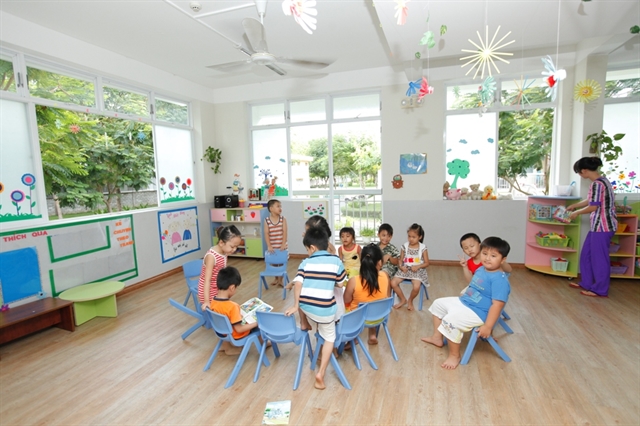 Economy
Economy

The disruption caused by the pandemic to production in industrial parks (IPs) and export processing zones (EPZs) is leading some to suggest a radical overhaul in the way in which these areas operate in the future.

|
| The children of workers in the Long Hậu kindergarten. — Photo courtesy of the firm |
Minh Hương
HÀ NỘI – The disruption caused by the pandemic to production in industrial parks (IPs) and export processing zones (EPZs) is leading some to suggest a radical overhaul in the way in which these areas operate in the future.
Experts said the practical application of more people-orientated models of work will help factories in IPs and EPZs across the country, enhancing productivity competitiveness, saving costs and protecting the environment.
Hoàng Quang Phòng, vice chairman of the Việt Nam Chamber of Commerce and Industry (VCCI), quoted data from the Ministry of Planning and Investment (MPI) when saying: “Việt Nam has 575 IPs and EPZs in 61 provinces and cities.”
Phòng added that they are home to thousands of local and international businesses from 122 countries and territories around the world.
However, many of these bases lack social infrastructure meaning they are failing to meet the needs of workers and the development of businesses.
Phòng said: “Most industrial parks mainly focus on building and developing infrastructure for production and focusing on profits, focussing on economic benefits without paying due attention to the development of social infrastructure for workers.”
He mentioned: “While workers have not yet settled down, it could affect the quality of labour and the economic, production and business development on the whole.”
As an example of how settling down could help, Long Hậu IP in Long An Province was highlighted as one of the top enterprises in Asia for its people-focused model.
Trần Hồng Sơn, general director of Long Hau JSC, told Viet Nam News: “The application of a customer-oriented approach has made Long Hậu one of the few IPs in the country that is highly appreciated by prestigious domestic and foreign organisations for business performance.”
Next to HCM City and connecting other provinces along the National Highway 50, the 500 ha IP in Long Hậu Commune does not follow the traditional IP model of other factories, but built itself as a close circle encompassing all the necessary infrastructure.
The IP includes a customs office, a standard wastewater treatment plant, a fire-fighting station, police station, service centre, polyclinic, kindergarten, convenience supermarket and a residential area with a capacity of more than 6,000 people.
The IP is home to 200 domestic and international firms, many of which have their headquarters and factories at the IP.
Sơn added, “We spent 33 per cent of the land fund to build public works as we want to make everything done in our IP.”
Sơn said that they provided accommodation for workers, helping them to contribute to the success of the firm. During the pandemic, the isolated accommodation helped reduce the risk of the virus spreading to the community.
With such facilities, Long Hậu IP is ready to offer favourable conditions to welcome a wave of new investment, production and business transformation of domestic and foreign enterprises to Long An.
On November 25 the IP launched a conference with their Korean partners, inviting them to stay with its IP in Đà Nẵng as the production hub of Việt Nam.
As another example, late last year, Nam Cầu Kiền IP in Hải Phòng City opened the so-called ‘Kyousei-no-niwa' Garden, a Japanese garden that covers 30,000 sq.m, using water directly treated from a wastewater treatment plant in the park.
The IP not only produces commodities but has all the typical features of an eco-park. Its production chains are circular from input to output through reuse, refurbishment and recycling of solid wastes and wastewater.
While experts said such facilities have met the basic requirements of a circular economy, which keeps products and materials in use for as long as possible to get the maximum value, chairman of the IP, Phạn Hồng Điệp, said the IP model aimed at creating a symbiotic association between the economy, environment and society to achieve the final goal of an increase in sustainable natural resources flows.
In the future, the Ministry of Construction (MoC) said it would coordinate with the relevant ministries and branches to study and potentially amend the Housing Law 2014 on the investment and construction of housing for workers in IPs and EZPs. Any amendments will be submitted to the National Assembly.
Hà Quang Hưng, deputy director of the Department of Housing and Real Estate Market Management, told local media: “The investment in social housing development, especially housing for workers in IPs, is a necessary solution to restore production and economy after the pandemic.”
In addition, MoC proposed that the provincial People's Committee must arrange accommodation for at least 50 per cent of workers in IPs.
The Government of Việt Nam considers the construction and development of industrial parks and economic zones a major policy to encourage socio-economic development. Recently, several regulations on IPs and EZs have been issued, amended and supplemented to improve the operational efficiency of these real estate facilities.
Decree No. 82 in 2018, on the management of IPs and EZ, has created a relatively complete legal basis to support enterprises in building and maintaining new real estate projects.
The National Assembly has also adopted the national land-use master plan for 2021-2030, with a vision to 2050, and a five-year land-use plan for 2021-2025. By 2030, the total land area of industrial property will rise by an additional 120,000ha. In 2021-2025, the designated land area for industrial real estate will increase by 62,000ha.– VNS

|




